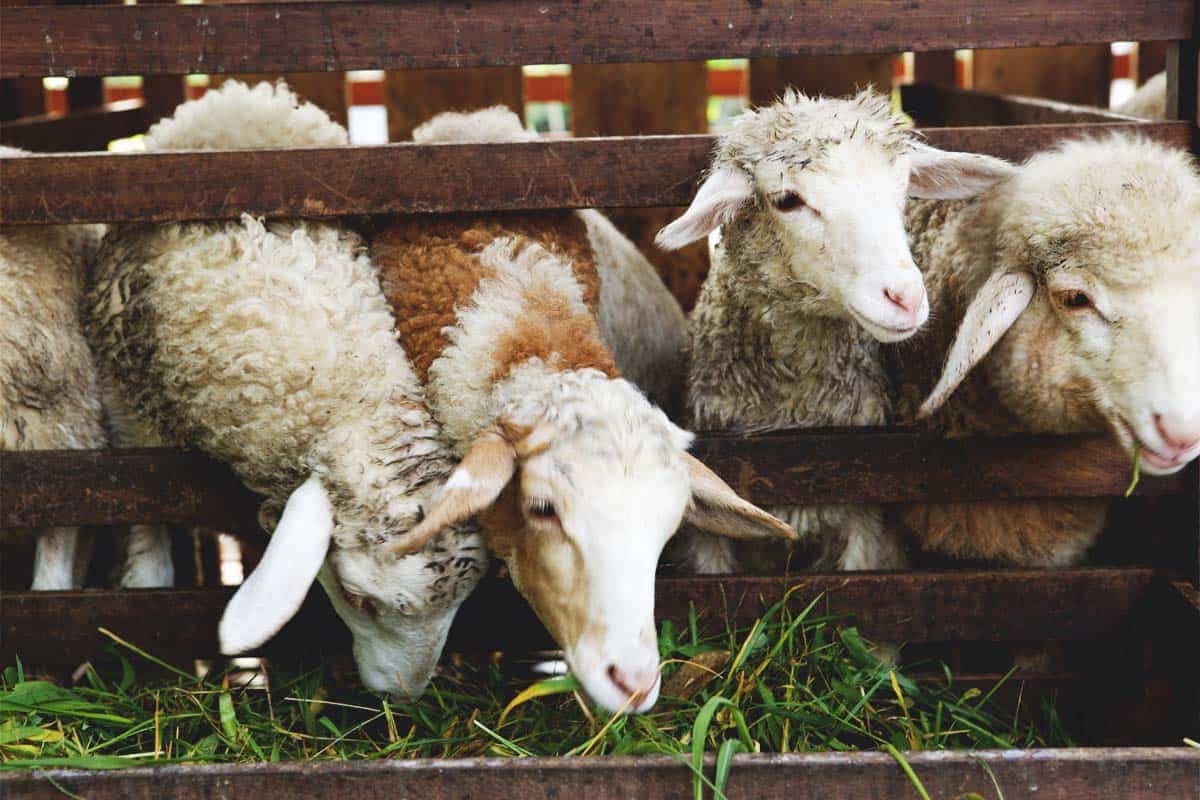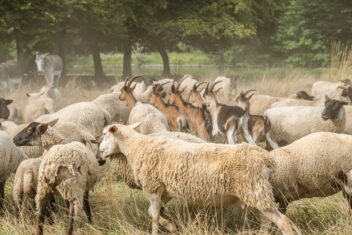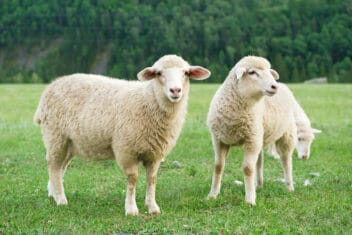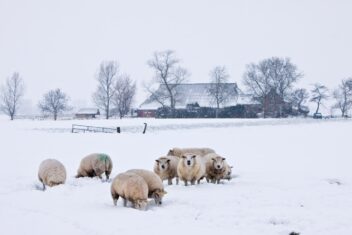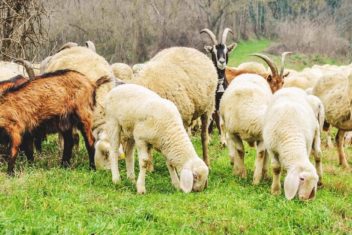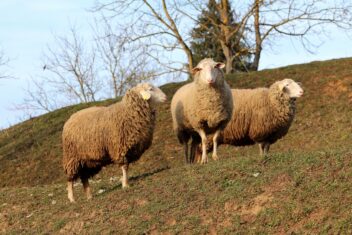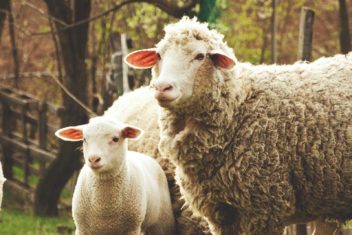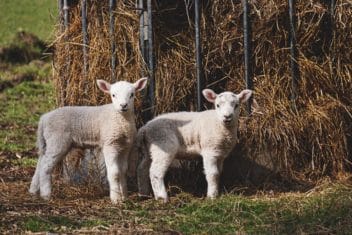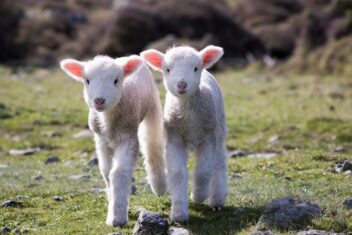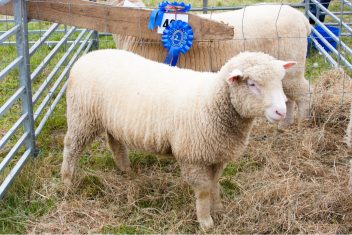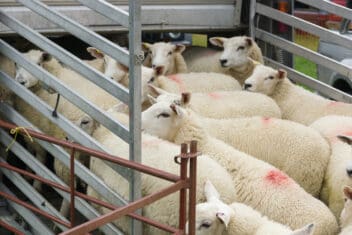If you’re new to raising sheep, knowing what to feed your flock can be downright overwhelming, and knowing what NOT to feed your flock is vitally important.
Like people, sheep don’t require specific, pre-formulated feeds. If you’re used to raising animals like chickens, ducks, or pigs, this can make the concept of feeding sheep much more complicated than it actually needs to be.
Sheep are simple animals, and with a little bit of know-how, you’ll be able to feed your sheep quickly, effectively, and easily—even if you’re on a tight budget.
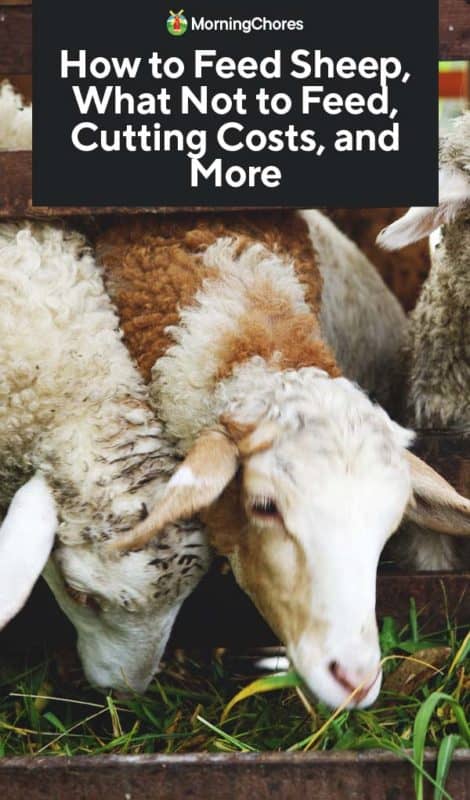
Why is Good Nutrition Important for Sheep?
Meeting the energy requirements of your sheep without overfeeding or underfeeding your flock can be a major challenge. In fact, most health problems in sheep are somehow tied to improper feed.
For example, pregnant ewes that are overfed are prone to pregnancy toxemia, while underfed animals are more likely to develop diseases related to those caused by internal parasites.
Sheep require the following nutrients in order to remain healthy:
- Carbohydrates (the largest portion of the diet)
- Protein (the most expensive portion of the diet)
- Salt, minerals, and vitamins
- Water
- Fiber
Failure to provide all of those nutrients in the right quantities, and nutritional diseases like bloat, milk fever, pregnancy toxemia, and many, many more can arise.
That might sound simple – “okay,” you might say, “I need to feed my sheep enough. Got it.”
However, when it really comes down to it, each sheep is highly individualized and their nutritional needs vary depending on the stage that they are currently in. For example, rams need more food than ewes, while pregnant and lactating ewes need much more specific food than non-pregnant ewes.
Don’t worry—I’ll break everything down for you, but first, let’s better understand how the food is processed.
Understanding the Digestive System
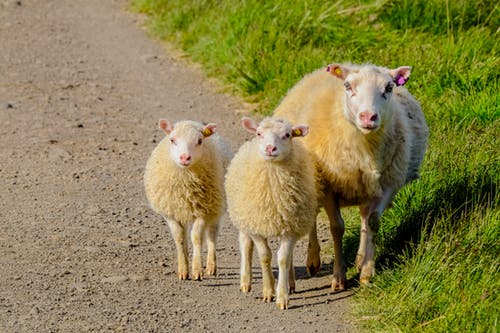
Sheep are ruminants, which means that they are characterized by a four-chambered stomach and cud-chewing behavior. The cud is regurgitated, re-chewed, and swallowed. Yum!
Sheep aren’t the only animals that do this. There are more than 150 different animals that belong to this classification, including bison, goats, cows, deer, and buffalo. Sheep are known as intermediate grazers, which means that they can usually consume both graze and browse (both high- and low-quality forage).
Lambs are not born with functioning rumens, which is why they first nurse from their mothers and then need to be switched over to a highly digestible creep feed. This helps the rumen as it is becoming developed.
Once they are mature, however, the rumen functions in a simple way.
When sheep eat food, it travels to the rumen, which takes up a large percentage of the abdominal cavity. It’s just a brief storage space, holding the food until it is regurgitated, chewed back up, and then re-swallowed (also known as cud-chewing). Usually, sheep will rest to do this and will not continue eating. Most sheep will chew their cud for several hours.
The rumen is an incredibly unique part of the body, serving as a fermentation vat with tons of micro-organisms. These micro-organisms, which include bacteria, help ruminants digest fibrous feeds like hay, which other animals (like yourself) would not be able to digest.
As this fermentation occurs, you may notice that your sheep audibly belch – it can be quite funny the first time you hear this!
Common Problems with Feeding Sheep
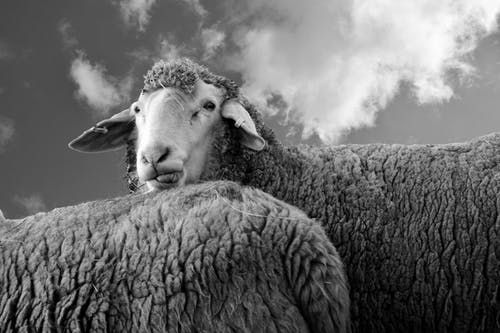
1. Raising Sheep With Other Species
Sheep can be raised with other animals, like goats and chickens, but you need to be careful about how you go about this. Sheep should not be allowed to access the grain or mineral supplements of any other species.
Not only will the grain contain minerals that, in excessive quantities, can make your sheep sick, but sheep can die from copper toxicity if they are given too much copper. Keep all feed supplies out of the reach of your sheep.
2. Feeding Poisonous Plants
Luckily, in most parts of the United States, there are very few plants that are poisonous for sheep. There are some weeds that aren’t great for your sheep and can be found growing in many pastures – such as ragwort, bracken, and capewood.
However, letting sheep graze through a garden space is a definite no-no. While you can feed your sheep most common garden weeds, they absolutely cannot eat things like foxglove, rhododendrons, oleander, and other toxic plants.
Unless you can positively identify each and every plant in your garden and know for sure that they are not toxic to sheep, don’t throw the clippings over the fence for your sheep to eat!
3. Failing to Pay Attention
When you feed sheep hay that was baled with string or twine, it’s important that you make sure you remove every last piece of the wrapping before letting your sheep dig in. It can cause severe blockages and kill your sheep.
4. Not Providing Enough Pasture
The amount of pasture you will need to feed your sheep is highly variable, as it depends on the quality of the soil, how much rainfall you get, what kind of forage is growing, and how you manage the pasture.
Plus, plants don’t grow at the same rate year-round. An acre of pasture in the spring and fall can support more sheep than an acre in the dry season – but again, this will depend on where you live.
You’ll have to monitor your own pasture and your own flock to figure out how much pasture is required, but you can make the most of your pasture space by only allowing your sheep to graze small sections at a time.
In a practice known as “rotational grazing,” you can restrict your sheep to certain chunks of land while other chunks regrow themselves.
Types of Feed For Your Sheep
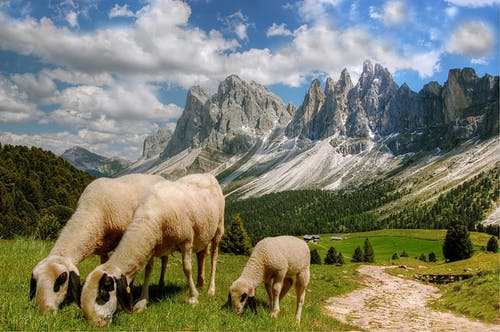
1. Pasture
Most sheep eat all kinds of pasture, including legumes, grass, forbs (weeds) and other pasture plants. Forbs are particularly desirable, and when sheep are allowed to graze freely in a pasture, you’ll find that they go for forbs first.
Forbs can be any kind of broadleaf plant besides grass, usually a flowering plant. Sheep will eat other types of plants, too, however, and there are nutritional benefits to providing a diverse array of plants in your pasture. Some breeds of sheep will even go after woodier growth!
When you are seeding a new pasture, your best bet is to seed a mixture of legumes and grasses. Try not to plant too many species at once, though, because this can make it difficult for each type of plant to develop. When selecting a forage mixture, consider some of the following options:
- Legumes (alfalfa, white clover, red clover, alsike clover, Kura clover, birdsfoot trefoil)
- Sod-forming grasses (Kentucky bluegrass, smooth bromegrass, reed canary grass)
- Bunch grasses (orchardgrass, timothy, tall fescue, Italian ryegrass, perennial ryegrass)
Choosing one plant type from each category is a good strategy if you’re just getting started.
2. Hay and Stored Feed
When fresh pasture isn’t available, the next best thing is stored feed. Sheep can eat hay, silage, green chop, balayage or crop by-products. Hay is the most common choice.
However, silage or haylage can also be fed to sheep, but you need to be careful about feeding it. It should be fermented and stored in a silo that keeps air out. Problems arise when silage becomes moldy, as it can cause listeriosis – a fatal disease in sheep.
3. Grain
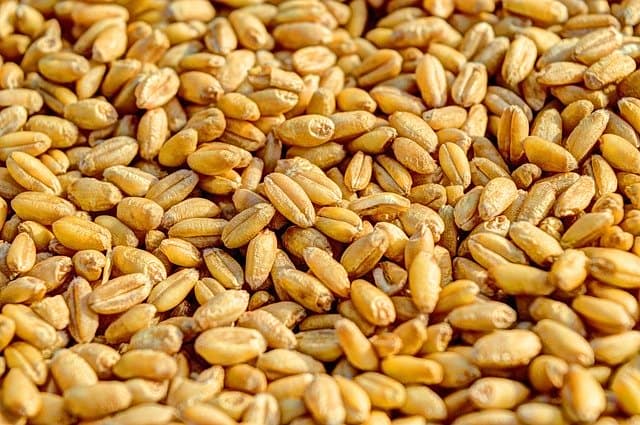
Sheep love grain – it’s about as appealing to them as a piece of decadent chocolate cake is to you! Unfortunately, though, it is very easy for sheep to over-eat if their grain consumption is not limited. You can add occasional grain, but be careful about feeding too much.
Keep in mind that the whole grain is going to be healthier for sheep as it requires them to grind their own grain. They’ll experience fewer digestive upsets.
It’s important to supplement grain to animals with higher nutritional needs, such as pregnant ewes toward the end of their gestation.
4. Salt and Mineral Supplementation
Sheep should have free access to sheep-formulated minerals. You can use a mineral block or loose minerals. Don’t worry about them over-eating from this supply, as they won’t eat it if they don’t actually need it.
A sheep supplement will contain the following:
- Calcium
- Sodium
- Chlorine
- Magnesium
- Phosphorous
- Vitamin A
- Potassium
- Sulfur
- Vitamin D
- Magnesium
- Vitamin E
- Trace amounts of cobalt, iodine, copper, iron, molybdenum, manganese, zinc, and selenium)
Make sure you use a sheep-specific supplement and do not use an all-stock or sheep and goat mixture. These often contain copper, which sheep do need – but in extremely small qualities. Sheep are ten times more likely to get copper toxicity than goats.
5. Snacks
In most cases, your sheep are going to get everything they need from a good lot of pasture and the occasional scoop of grain. However, it can be tough to resist the cuteness of those adorable sheep eyes begging you for a treat!
You can feed the following treats (in moderation) to your sheep:
- Black oil sunflower seeds (which can improve their coat)
- Alfalfa cubes (females only)
- Carrots
- Apples
- Celery
- Lettuce
- Grapes
- Oats
- Pumpkin
- Pears
- Watermelon
- Squash
The Right Way to Feed Sheep
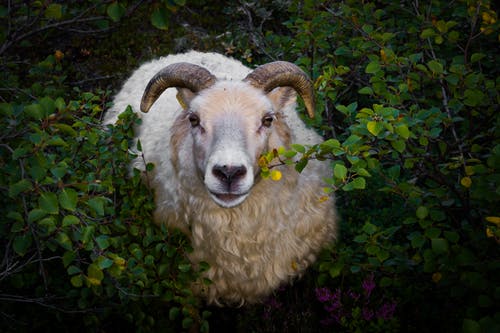
1. Get the Right Equipment
You’ll want to invest in at least three separate feeders: one for hay, one for grain, and one for minerals.
A hay feeder is necessary because sheep will not eat hay that has been trampled underfoot. If you are using baled hay to feed your sheep, use a shape-friendly feeder that will keep the living space clean and reduce waste. It will save you money.
A sheep-specific feeder is necessary, though, as those that are designed for other animals, like horses, have designs that allow sheep to get their heads stuck inside.
You can use basic troughs for feeding out grain and mineral supplements.
You’ll also need a good waterer. You can use an automatic watering system or one with a thermostat for automated heating. This will minimize spillage and keep the sheep hydrated in cold weather.
A basic watering trough works too, but you need to make sure you clean it out regularly as sheep have a tendency to poop directly in the water supply!
2. How Much Feed Does One Sheep Need?
The average sheep needs to eat about 0.03 pounds of hay or pasture per pound of body weight. More food is necessary if your sheep are very young or very old, pregnant or lactating, health-compromised, or being raised in the colder months.
They also need about a pound of fiber each day. You’ll be able to tell that your sheep aren’t getting enough fiber if they start nibbling on wood or even wool.
A good way to tell if your sheep are being under- or over-fed is to look after body condition. If the backbone is sticking out, your sheep is too thin. If there is a blob of fat above the tail, the sheep are too fat.
What to Feed Baby Lambs
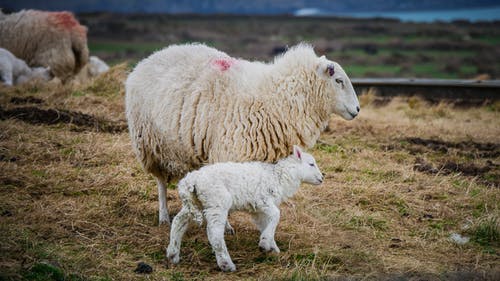
For the first few weeks of life, all a lamb needs to stay healthy and to grow is the milk from its mother. It is especially important that baby lambs take in colostrum during the first few hours after lambing.
After 24 hours, a ewe will no longer produce colostrum. It not only helps lambs develop their early immune systems, but it also helps them ward off hypothermia. Lambs need at least 10% of their body weight in colostrum within the first day of life.
Then, they will solely consume milk until they are about four to six weeks old. They will then start nibbling on solid food, like grass, hay, and grain. It is perfectly fine to allow your ewes to decide when to wean their young, or you can wean them sooner if you need to.
Young lambs – or those that are just a couple of weeks old – are often fed creep feed to help them win. Creep feed is when supplemental feed is offered to nursing lambs in addition to milk from their mothers.
You must use feed specifically designed for this purpose, as lambs that are this young cannot digest feeds meant for adult sheep.
What to Feed Pregnant Ewes
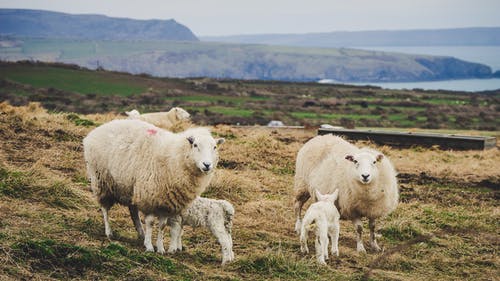
Making sure you feed your pregnant and lactating ewes adequately is the key to guaranteeing healthy lambing!
A common mistake that many people make is assuming that sheep need more calories throughout their entire pregnancy. That’s not the case. You really only need to increase nutrition during the final four to six weeks of pregnancy, which is when nearly 70% of all lamb development occurs.
You’ll need to add significantly more protein and dietary energy at this time, as ewes who are not in good condition can suffer from pregnancy toxemia and deliver lighter, weaker lambs. On average, a 150 lb ewe will need to be fed roughly four and a half pounds of feed per day during her final gestation period.
Don’t adjust her diet all at once when you move into that final six weeks, though. It shouldn’t be an abrupt shift. Instead, gradually increase her feed or allow her free access to a hay feeder to make sure she is getting what she needs.
You will also need to provide this amount of additional feed (perhaps up to a pound more than while your ewes were pregnant) while your ewes are lactating, primarily during the first six to eight weeks after lambing.
Remember that ewes that delivered twins or triplets will need more nutrients, as they produce at least 20 – 30% more milk than ewes sculling singles.
Feeding in the Winter
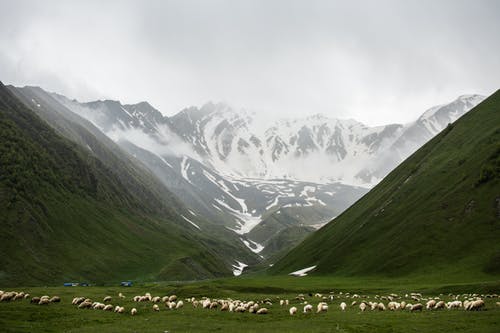
Sheep require more nutrition in the winter to help them stay warm. You can feed them the same foods you would have fed them during the summer, but keep in mind, of course, that if you live in a cold area they won’t have access to pasture.
It can be difficult to determine how much hay your sheep will need during the winter, as this is dependent on so many factors.
There is always the risk of running out of hay in winter especially if you don’t know how much they are going to eat. So we have some suggestions on how to find hay in winter for you.
However, providing your sheep with free access to their feed is a good way to deal with this, as they’ll figure it out for themselves and usually will not overfeed (but it’s good to keep an eye out for signs of this regardless).
The one exception is when it comes to water. Sheep consume up to 12 times more water in the summer than they do in the winter, so you likely won’t find that your sheep are drinking as much (unless they are gestating or lactating).
Feeding Sheep for Slaughter
Lambs or adult sheep are generally finished on pasture or with grain in confinement. You can also supplement with grain and allow them to graze on pasture. Pasture-finished meat tends to be leaner and healthier than meat from grain-fed lambs.
How to Cut the Costs of Feeding Sheep
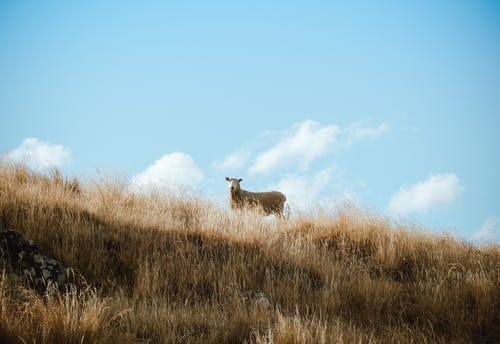
There are several easy ways that you can reduce the expenses involved when feeding sheep.
The first is to become more skilled at managing your pasture. Not only are sheep healthier and produce better quality wool, milk, and meat when they are raised primarily on pasture, but it’s essentially free for you to feed them (without the costs of labor or seeds factored in, of course).
Educate yourself as much as possible on the nutritional requirements of sheep, and do your best to slash costs wherever you can. If you don’t have a lot of pasture and can’t afford to buy more acreage, why not rent out some pasture? This is often cheaper than buying hay, and some people will even let you do it for free.
After all, they don’t have to mow their lawns anymore!
Supplying plenty of water can also help improve your feed conversion, as can taking steps to keep parasites (which cause extreme weight loss) at bay.
Keeping your costs as low as possible is always advisable. So, have a look at our article on cost-cutting tips for sheep farmers on how to go about saving as much as you can.
Watering Your Sheep
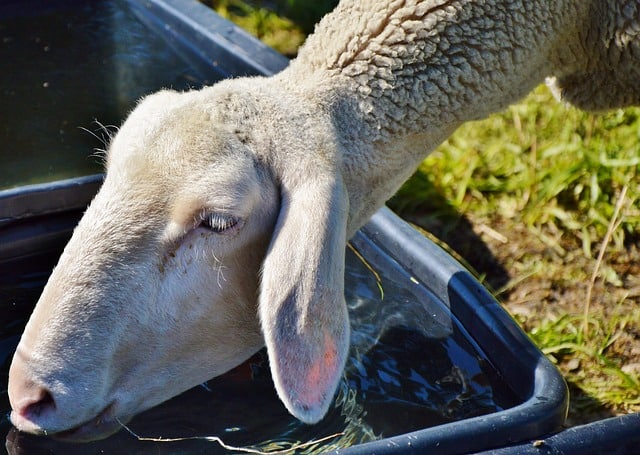
Without a doubt, water is one of the most important things to provide for sheep. How much water to give to sheep will vary depending upon the breed, climate, size, and production status of the sheep.
Some sheep producers will argue that you can go an entire winter without providing sheep any freshwater, as they’ll eat the snow, but this isn’t a great idea.
Not only can it lead to contamination, but it can easily cause dehydration. Plus, it will take more energy for the bodies of your sheep to warm up the water from the icy snow. Mostly she needs about one or two gallons of water each day.
What Not to Feed Sheep
There are some foods that should be off-limits (or fed in extreme moderation) to a flock of sheep.
1. Bread
Many people feed bread to sheep. In small doses, it’s probably fine – but in high volume, it can lead to obesity and a variety of other health conditions.
2. Blue-Green Algae
Of course, you’re probably not feeding blue-green algae to your sheep. However, this type of algae, generally found in warm, slow-moving waters, can be incredibly poisonous to sheep. Keep an eye on your water supply in warm weather to make sure it’s not forming algae.
3. Alfalfa
Small amounts of alfalfa can be fed to sheep, but sheep should not be grazed on pasture that is predominantly alfalfa. It has a high level of protein and calcium that can cause urinary blockages and obesity.
You should only feed alfalfa as a treat to young babies or pregnant females – don’t feed it to castrated males.
4. Animal Products
Sheep should not be fed animal products (including meat and dairy) of any kind, as these can be toxic.
5. Certain Plants
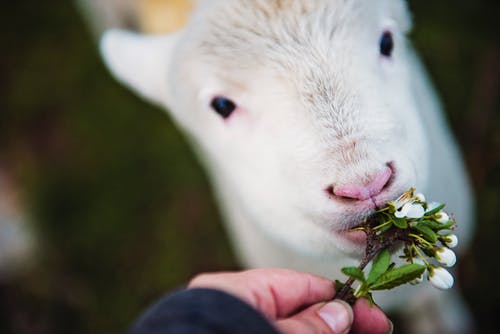
Some plants are toxic to sheep either because they contain harmful toxins or because they contain too much of a certain nutrient for your sheep to digest effectively.
Avoid feeding any of the following items and restrict pasture access where these plants are growing:
- Avocado
- Bracken ferns
- Broccoli
- Turnips
- Cabbage
- Buttercup
- Azaleas
- Cassava
- Cherry trees
- Elderberry trees
- Kale
- Chokecherry trees
- Plum trees
- Hemlock
- Lilacs
- Holly trees
- Lily of the valley
- Ponderosa pine
- Potato
- Poppy
- Milkweed
- Any nightshades
- Mountain laurel
- Red maple
- Rhubarb
- St. John’s Wort
- Yew
What to Keep in Mind When Feeding Sheep
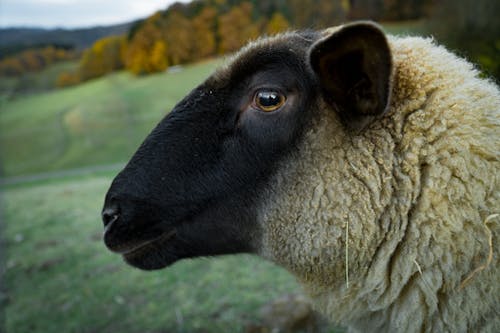
While all of the information supplied above should serve as a good general guide to feeding your sheep, remember that each individual sheep will be highly variable in his or her nutritional needs, likes, and dislikes.
Therefore, the best way to care for your flock is to keep an eye on them and interact with them each and every day. By learning exactly what makes each individual tick, you’ll be on your way to a happy, healthier flock!
